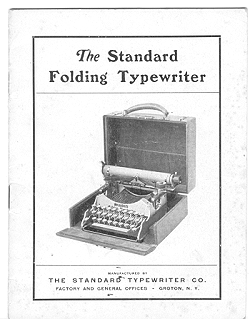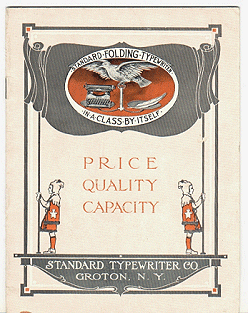|

|
 According to the first company brochure of 1908-9, the Standard Folding was
quite simply ‘Surpassed by none in Design, Material, Workmanship, Quality of
Work or Operative Advantages.’ The early brochures also make it
clear who the manufacturers were aiming at with their new machine. 'The Standard
Folding Typewriter,' they said, 'is the ideal writing machine for
travelers. It is perfectly adapted to the requirements of commercial
travelers, business men of all classes who travel and who must look after their
enterprises while on their journeys, journalists, travel writers, and reporters
on distant assignments, clergymen, lecturers, explorers, authors, and all other
professional people, theatrical and vaudeville managers and stars, society
people and all others who conduct their private correspondence upon the
typewriter.' The boys in the marketing department were far from shy about making claims for their
product or comparing it in superlative terms with the competitive machines on
the market. Their 1910 manual is even more extravagant in praise of their own
product. It says simply; According to the first company brochure of 1908-9, the Standard Folding was
quite simply ‘Surpassed by none in Design, Material, Workmanship, Quality of
Work or Operative Advantages.’ The early brochures also make it
clear who the manufacturers were aiming at with their new machine. 'The Standard
Folding Typewriter,' they said, 'is the ideal writing machine for
travelers. It is perfectly adapted to the requirements of commercial
travelers, business men of all classes who travel and who must look after their
enterprises while on their journeys, journalists, travel writers, and reporters
on distant assignments, clergymen, lecturers, explorers, authors, and all other
professional people, theatrical and vaudeville managers and stars, society
people and all others who conduct their private correspondence upon the
typewriter.' The boys in the marketing department were far from shy about making claims for their
product or comparing it in superlative terms with the competitive machines on
the market. Their 1910 manual is even more extravagant in praise of their own
product. It says simply;
Claims made for the Standard Folding Typewriter:
* That it
possesses all the essential features of the latest and most popular high-priced
machines
* That it is the peer of any such machine
in the excellence of its material and the quality of its workmanship.
* That it surpasses all such machines in
simplicity of design, compactness and fewness of parts.
* That it is fully the equal of any such
machine in the character and quality of its work.
* That its strength and durability are
more than adequate for every possible requirement.
* That at its price (Fifty Dollars) it is
the greatest typewriter value known.
Fifty dollars was a remarkably economical price and it was
one that the company kept to with the later Corona 3, throughout the First War
and into the 1920s. From the earliest days, it exported overseas models to
the lucrative export markets in England, Germany and France, equipped with
different language keyboards. The same brochure of around 1910 introduced a smart new logo
of a pigeon holding a pair of scales that was to
become one of the best recognised in the typewriter industry in years to come,
but in association with the Corona machine, soon to be launched in 1912. The company also made its own 'Pigeon Brand' ribbons. The two brochures illustrated
here, in uniquely mint condition,  were among
the personal effects of Frank Rose, presumably sent by the company to his widow
or his son, George, as a token of the company's successful achievement in taking a
brilliant invention and turning it into a commercial success.
were among
the personal effects of Frank Rose, presumably sent by the company to his widow
or his son, George, as a token of the company's successful achievement in taking a
brilliant invention and turning it into a commercial success.
One thing that all this industrious marketing uncovered
was that customers in France and Germany found the name 'Standard Folding
Typewriter' difficult to pronounce and hard to understand. The marketing
boys put their heads together seeking a name that would be universally
understood. They found that the Latin for 'crown' had found its way into
most languages and settled on the name 'Corona' for the machine that was being
redesigned in the company research department by chief of research Otto
Petermann.
|


 According to the first company brochure of 1908-9, the Standard Folding was
quite simply ‘Surpassed by none in Design, Material, Workmanship, Quality of
Work or Operative Advantages.’ The early brochures also make it
clear who the manufacturers were aiming at with their new machine. 'The Standard
Folding Typewriter,' they said, 'is the ideal writing machine for
travelers. It is perfectly adapted to the requirements of commercial
travelers, business men of all classes who travel and who must look after their
enterprises while on their journeys, journalists, travel writers, and reporters
on distant assignments, clergymen, lecturers, explorers, authors, and all other
professional people, theatrical and vaudeville managers and stars, society
people and all others who conduct their private correspondence upon the
typewriter.' The boys in the marketing department were far from shy about making claims for their
product or comparing it in superlative terms with the competitive machines on
the market. Their 1910 manual is even more extravagant in praise of their own
product. It says simply;
According to the first company brochure of 1908-9, the Standard Folding was
quite simply ‘Surpassed by none in Design, Material, Workmanship, Quality of
Work or Operative Advantages.’ The early brochures also make it
clear who the manufacturers were aiming at with their new machine. 'The Standard
Folding Typewriter,' they said, 'is the ideal writing machine for
travelers. It is perfectly adapted to the requirements of commercial
travelers, business men of all classes who travel and who must look after their
enterprises while on their journeys, journalists, travel writers, and reporters
on distant assignments, clergymen, lecturers, explorers, authors, and all other
professional people, theatrical and vaudeville managers and stars, society
people and all others who conduct their private correspondence upon the
typewriter.' The boys in the marketing department were far from shy about making claims for their
product or comparing it in superlative terms with the competitive machines on
the market. Their 1910 manual is even more extravagant in praise of their own
product. It says simply; were among
the personal effects of Frank Rose, presumably sent by the company to his widow
or his son, George, as a token of the company's successful achievement in taking a
brilliant invention and turning it into a commercial success.
were among
the personal effects of Frank Rose, presumably sent by the company to his widow
or his son, George, as a token of the company's successful achievement in taking a
brilliant invention and turning it into a commercial success.